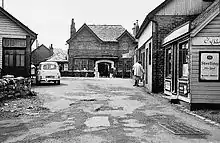Mallaig railway station
Mallaig railway station is a railway station serving the ferry port of Mallaig, Lochaber, in the Highland region of Scotland. This station is a terminus on the West Highland Line, 41 miles (66 km) by rail from Fort William and 164 miles (264 km) from Glasgow Queen Street.
 | |
| Location | Mallaig, Highland Scotland |
| Coordinates | 57.0056°N 5.8302°W |
| Grid reference | NM675970 |
| Managed by | Abellio ScotRail |
| Platforms | 2 |
| Other information | |
| Station code | MLG |
| History | |
| Original company | Mallaig Extension Railway of West Highland Railway |
| Pre-grouping | North British Railway |
| Post-grouping | LNER |
| Key dates | |
| 1 April 1901 | Station opened[2] |
| Passengers | |
| 2015/16 | |
| 2016/17 | |
| 2017/18 | |
| 2018/19 | |
| 2019/20 | |
| Notes | |
Passenger statistics from the Office of Rail and Road | |
History


Mallaig station opened on 1 April 1901.[2]
The station was laid out as an island platform with tracks on either side. There were sidings on both sides, and a turntable to the south of the station, on the west side of the line, right beside the sea.
Until 1968 two tracks continued down onto the pier, which was built and originally owned by the West Highland Railway Company. The tracks were removed when the harbour passed from British Rail ownership to that of the Mallaig Harbour Authority.
The glass overall roof was removed in 1975 and the ticket office was extended at the same time.
Services
.jpg.webp)


Scheduled train services out of Mallaig railway station are operated by Abellio ScotRail. Currently, four trains a day depart Monday to Saturdays from Mallaig for Fort William, three of which continue to Glasgow (the fourth connects at Fort William with the Caledonian Sleeper to London Euston). On Sundays three trains depart Mallaig for Fort William, with two trains continuing on to Glasgow.[3]
The railway line from Mallaig is noted as a scenic route, especially as it passes along the Glenfinnan Viaduct 37 kilometres (23 mi) out of Mallaig.[4][5]
Mallaig is also the destination of a special tourist steam train operated by West Coast Railways, The Jacobite, which runs sightseeing trips from Fort William to Mallaig from May to October. The service runs twice daily, Monday to Friday with additional weekend services during the summer months. The Jacobite steam train is known for its association with the Harry Potter film series, particularly due to its route along the Glenfinnan Viaduct, which featured in the Harry Potter films.[4]
Ferry services
| Caledonian MacBrayne | |||||||||||||||||||||
|---|---|---|---|---|---|---|---|---|---|---|---|---|---|---|---|---|---|---|---|---|---|
| |||||||||||||||||||||
Mallaig ferry port is located in front of the railway station, approximately 130 metres (430 ft) away.
Caledonian MacBrayne operate ferry services from Mallaig to Armadale on the Isle of Skye, a thirty-minute sailing, as well as daily services to the Small Isles of Canna, Rùm, Eigg and Muck, although the timetable, itinerary and calling points differ from day to day. A small, independent ferry service run by former lifeboatman Bruce Watt sails up Loch Nevis to the remote village of Inverie in Knoydart, and also calls by prior arrangement at Tarbet in Morar, locations that are only accessible by sea. Both Cal Mac and Bruce Watt also offer non-landing sightseeing tickets.
Signalling

From the time of its opening in 1901, the Mallaig Line was worked throughout by the electric token system. Mallaig signal box was situated south of the station, on the east side of the line.
On 14 March 1982, the method of working on the section between Arisaig and Mallaig was changed to One Train Working (with train staff). Mallaig signal box was closed as a token station, but retained as a ground frame with four levers. All the semaphore signals were removed.
On 6 December 1987 the Radio Electronic Token Block (RETB) system was commissioned between Mallaig Junction (now called 'Fort William Junction') and Mallaig. The RETB is controlled from a Signalling Centre at Banavie railway station.
In November 1992, the former signal box was demolished and replaced by an ordinary ground frame.
The Train Protection & Warning System was installed in 2003.
| Preceding station | Following station | |||
|---|---|---|---|---|
| Morar | Abellio ScotRail West Highland Line |
Terminus | ||
| Arisaig | West Coast Railways The Jacobite May–October |
Terminus | ||
| Armadale | Caledonian MacBrayne Mallaig – Skye |
Terminus | ||
| Lochboisdale | Caledonian MacBrayne Mallaig – South Uist |
Terminus | ||
| Rùm | Caledonian MacBrayne Mallaig – Small Isles |
Terminus | ||
| Eigg | ||||
| Muck | ||||
| Canna | ||||
| Inverie | Western Isles Cruises[6] Mallaig – Knoydart |
Terminus | ||
| Inverie | Knoydart Ferry[7] Mallaig – Knoydart |
Terminus | ||
| Historical railways | ||||
| Morar Line and Station open |
North British Railway West Highland Railway (Mallaig Extension Railway) |
Terminus | ||
References
Notes
- Brailsford 2017, Gaelic/English Station Index.
- Butt (1995)
- GB eNRT 2016 Edition, Table 227 (Network Rail)
- Townsend, Chris (2011). Scotland. Milnthorpe: Cicerone. p. 317. ISBN 9781849653534.
- "Highland train line best in world". BBC News. 6 February 2009. Retrieved 14 August 2014.
- https://westernislescruises.co.uk/
- http://www.knoydartferry.com/timetable/
Sources
- Brailsford, Martyn, ed. (December 2017) [1987]. Railway Track Diagrams 1: Scotland & Isle of Man (6th ed.). Frome: Trackmaps. ISBN 978-0-9549866-9-8.
- Butt, R. V. J. (1995). The Directory of Railway Stations: details every public and private passenger station, halt, platform and stopping place, past and present (1st ed.). Sparkford: Patrick Stephens Ltd. ISBN 978-1-85260-508-7. OCLC 60251199.
- Jowett, Alan (March 1989). Jowett's Railway Atlas of Great Britain and Ireland: From Pre-Grouping to the Present Day (1st ed.). Sparkford: Patrick Stephens Ltd. ISBN 978-1-85260-086-0. OCLC 22311137.
- Jowett, Alan (2000). Jowett's Nationalised Railway Atlas (1st ed.). Penryn, Cornwall: Atlantic Transport Publishers. ISBN 978-0-906899-99-1. OCLC 228266687.
- RAILSCOT on Mallaig Extension Railway
External links
![]() Media related to Mallaig railway station at Wikimedia Commons
Media related to Mallaig railway station at Wikimedia Commons